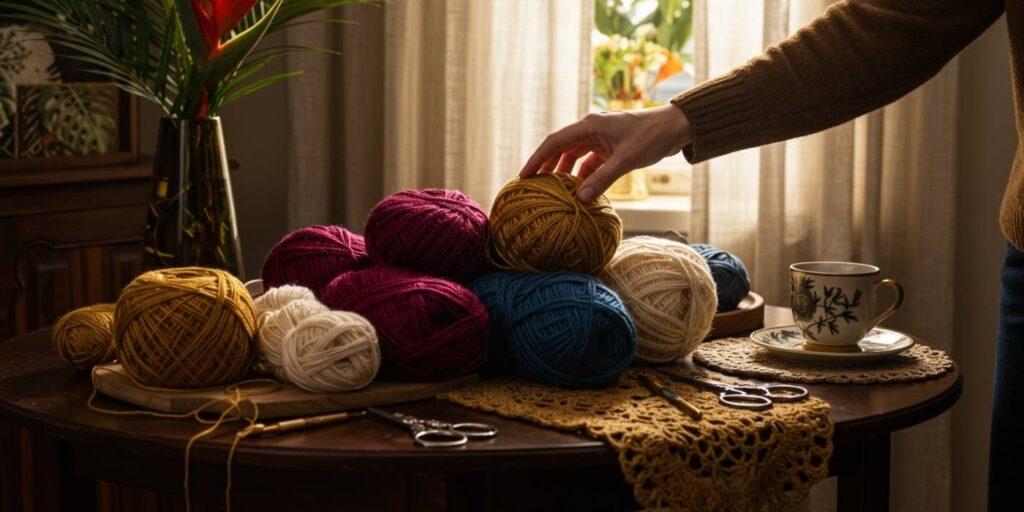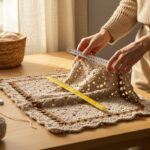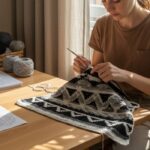Introduction: The Whisper of Silk, the Hug of Cashmere — Why Luxury Yarns Are Worth It
There’s a moment — maybe you’re knitting in your favorite chair, fingers gliding over soft fibers, steam from your tea curling into the air — when you realize: not all yarns are created equal. Some feel like a whisper against your skin. Others hold warmth like a secret. And then there are the luxury yarns — the ones that make your heart skip a stitch.
Luxury fibers aren’t just for the elite or the Instagram-famous. They’re for anyone who’s ever paused mid-project, looked at their hands, and thought: This deserves to feel extraordinary.
In this article, we’ll unravel the mystery of premium yarns — not just what they are, but when to invest in them, how to choose wisely, and why they can transform your crafting experience from routine to ritual. Whether you’re knitting a baby blanket, crocheting a shawl for a best friend’s wedding, or weaving a scarf that’ll outlive trends, luxury fibers can elevate your work — emotionally, aesthetically, and even functionally.
We’ll explore the magic behind fibers like cashmere, silk, alpaca, and qiviut. We’ll break down cost versus value, share real-life scenarios where splurging makes sense, and offer practical tips to stretch your budget without sacrificing joy. And yes — we’ll also talk about when not to splurge (because let’s be real: sometimes acrylic is perfectly fine).
Ready to treat your needles — and your soul — to something special? Let’s dive in.
1. What Makes a Yarn “Luxury”? Beyond Price Tags and Fancy Labels
Let’s get one thing straight: luxury isn’t just about cost. It’s about experience.
A $50 skein of yarn isn’t automatically “luxury” just because it’s expensive. And a $12 skein isn’t “cheap” if it brings you pure joy and performs beautifully. True luxury yarns are defined by:
- Fiber origin (Is it rare? Ethically sourced? Hand-combed?)
- Feel and drape (Does it glide? Does it hug the body?)
- Durability and aging (Will it pill? Will it soften over time?)
- Emotional resonance (Does it make you feel something?)
Take qiviut, for example — the undercoat of the Arctic muskox. It’s softer than cashmere, eight times warmer than wool, and doesn’t shrink or felt. A single scarf can cost hundreds of dollars… but it’ll last decades, never lose its luster, and literally keep you warm in sub-zero temperatures. That’s not extravagance — that’s investment.
Or consider peace silk (also called Ahimsa silk), harvested without harming silkworms. It’s slightly less glossy than conventional silk, but carries an ethical weight that many crafters find deeply meaningful.
Here’s the key takeaway: Luxury yarns aren’t about showing off. They’re about intention. When you choose a premium fiber, you’re not just buying material — you’re investing in a story, a sensation, a legacy.
Pro Tip: Before splurging, ask yourself:
- Will this project be worn close to the skin?
- Is it a gift for someone special?
- Will it be used daily or saved for moments that matter?
If you answered “yes” to any of these — luxury might be worth it.
2. When to Splurge: The Projects That Deserve Premium Fibers
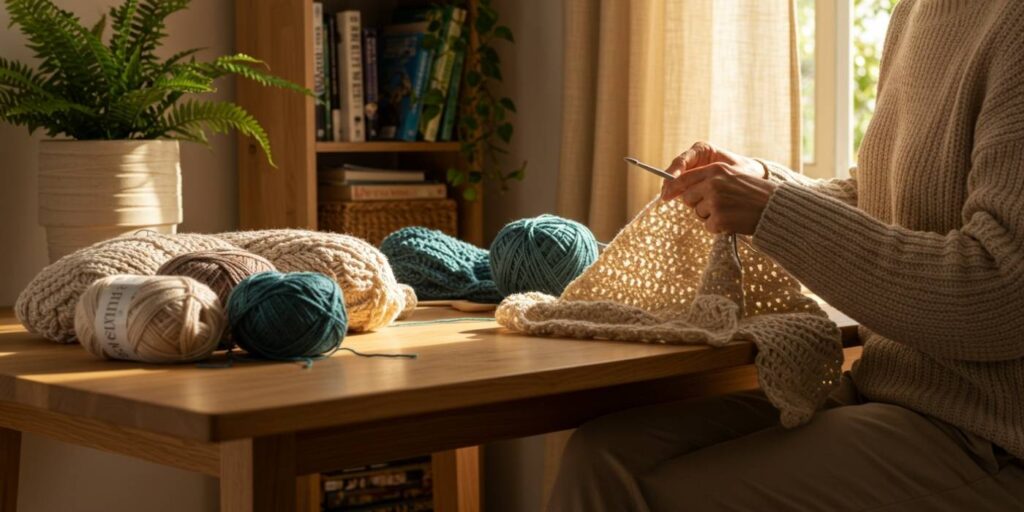
Not every project needs mohair from Patagonia or hand-dyed merino from a Vermont farm. But some? Oh, some absolutely do.
Here are the top 5 moments when reaching for luxury yarn isn’t indulgence — it’s wisdom:
A. Heirloom Gifts
Think baby blankets, wedding shawls, milestone birthday sweaters. These aren’t just items — they’re future memories. A cashmere-blend blanket will feel like a hug for decades. A silk-cashmere lace shawl? It’ll drape like liquid moonlight at the wedding — and be treasured in a cedar chest for generations.
B. Items Worn Close to Skin
Necklines, cuffs, socks, underwear (yes, some people knit silk undies — no judgment!). If it touches sensitive skin, luxury fibers reduce irritation and increase comfort. Superwash merino, bamboo, or silk blends? Perfect for eczema-prone kids or partners who hate “itchy sweaters.”
C. Statement Pieces You’ll Wear for Years
That oversized cardigan you’ll live in every winter? The shawl you’ll drape over your shoulders at conferences and coffee shops? Invest here. Premium fibers age gracefully — they soften, they bloom, they become yours in a way fast-fashion knits never can.
D. Projects That Challenge Your Skills
Sometimes, luxury yarns deserve your best work. Intricate lace? Try silk — it holds stitch definition like nothing else. Complex colorwork? A high-twist merino will make your floats behave. Reward your effort with materials that honor it.
E. Emotional or Therapeutic Knitting
Grieving? Celebrating? Healing? The tactile pleasure of a buttery-soft alpaca or the cool slide of silk can be deeply soothing. Don’t underestimate the mental health ROI of a truly beautiful yarn.
Real-Life Example:
Sarah, a nurse from Oregon, bought a single skein of hand-dyed cashmere to knit during her mother’s chemo treatments. “It was the only thing that calmed my hands,” she says. “Now Mom wears the cowl I made — and every time she does, we both feel that peace again.”
3. How to Splurge Smart: Stretching Your Budget Without Sacrificing Joy
Let’s be honest: luxury yarns can hurt the wallet. But you don’t need to drain your savings to enjoy them. Here’s how to be strategic:
A. Mix Fibers Like a Pro
Blend luxury with budget. Knit a sweater body in a soft, affordable merino — then splurge on cashmere or silk for the collar, cuffs, and hem. You get the luxury feel where it counts, without the luxury price tag.
B. Buy Singles, Not Sweater Quantities
One skein of something divine can go a long way. Use it for:
- A luxurious hat or cowl (worn close to the face = maximum impact)
- Accent stripes in a larger project
- Embellishments — tassels, edgings, or i-cord details
C. Shop Sales, Swaps, and Stash Dives
- Follow indie dyers on Instagram — they often run “update sales” or destash quietly.
- Join Ravelry groups like “Luxury Yarn Lovers” or “Stash Enhancement Society” — members often trade or sell partial skeins.
- Check your own stash. Sometimes that lone skein of silk you bought “just because” is exactly what your next project needs.
D. Think Small — Literally
Luxury yarns shine in small projects:
- Fingerless gloves
- Ear warmers
- Book sleeves
- Coasters (!) — yes, silk-blend coasters feel amazing and make your coffee ritual feel elevated.
E. Calculate Cost Per Wear
That $120 silk-blend sweater you’ll wear 100 times? That’s $1.20 per wear. The $30 acrylic sweater you’ll wear twice before it pills and you donate it? That’s $15 per wear. Suddenly, luxury looks… economical.
Budget Hack:
Set a “yarn splurge fund.” Put $5 in a jar every time you finish a project. In six months, you’ll have enough for that skein of yak you’ve been eyeing — guilt-free.
4. The Hidden ROI of Luxury Yarns: Why They’re Worth Every Penny
Still on the fence? Let’s talk returns — not just financial, but emotional, creative, and even environmental.
A. Emotional ROI: The Joy Multiplier
There’s science behind this. Tactile pleasure releases dopamine. Working with a fiber that feels incredible? That’s self-care. Gifting something handmade from luxury materials? That’s love made visible. Wearing it? That’s confidence woven in.
B. Creative ROI: Better Results, Fewer Frustrations
Premium fibers behave better. They don’t split. They don’t shed. They block beautifully. Your stitches look crisper. Your tension evens out. Your finished object? It looks — and feels — like it was made by a pro (even if you’re still learning).
C. Environmental & Ethical ROI
Many luxury fibers come from small farms, ethical cooperatives, or regenerative sources. Alpaca? Often raised without chemicals. Organic cotton? Grown without pesticides. Supporting these producers means voting with your needles for a better world.
D. Longevity ROI: Buy Once, Cry Once (But Happily)
Fast fashion yarns pill, stretch, fade. Luxury fibers? They age like wine. A well-cared-for cashmere sweater can last 20+ years. That’s not consumption — that’s curation.
Story Time:
Elena, a teacher from Maine, inherited her grandmother’s 1940s-era lace shawl — made from hand-spun silk. “It’s fragile now,” she says, “but when I drape it over my shoulders, I swear I can feel her hands guiding mine. No machine-made acrylic could ever hold that kind of magic.”
5. Luxury Doesn’t Mean Perfect: Common Myths (and How to Avoid Regret)
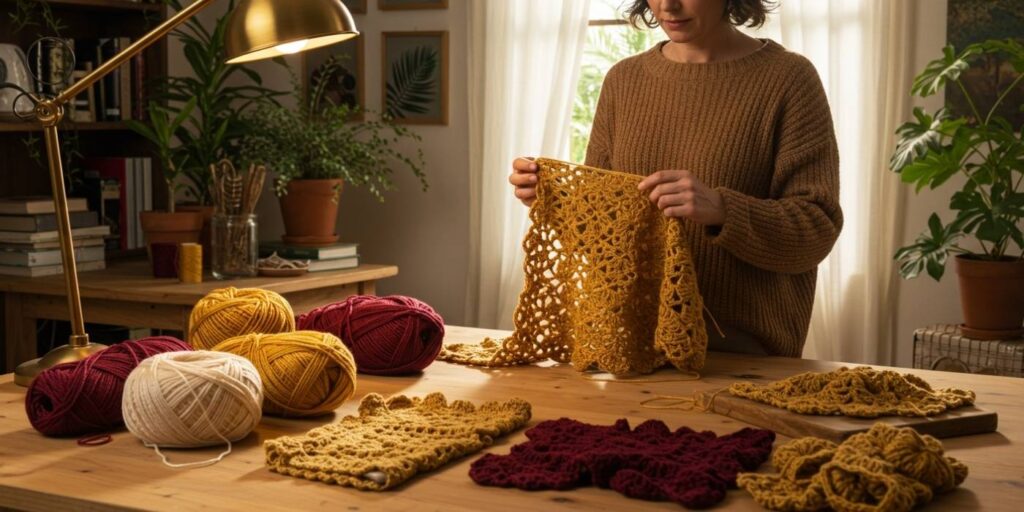
Before you click “Add to Cart” on that $85 skein of baby camel, let’s bust some myths:
Myth #1: “Luxury = No Maintenance”
False. Cashmere needs gentle hand-washing. Silk can be finicky. Always check care instructions — and be honest with yourself about whether you’ll actually follow them. (If you hate blocking, maybe skip the lace-weight silk.)
Myth #2: “All Luxury Yarns Are Ethical”
Not true. Some “luxury” brands source from questionable suppliers. Do your research. Look for certifications like GOTS (Global Organic Textile Standard) or WOOLMARK. Support transparent indie dyers.
Myth #3: “If It’s Expensive, It Must Be Good for Every Project”
Wrong. That slubby art yarn? Gorgeous for a wall hanging — terrible for socks. That ultra-fine lace silk? Divine for shawls — frustrating for beginners. Match the fiber to the function.
Myth #4: “I’m Not ‘Good Enough’ to Use Luxury Yarn”
Stop. Right now. You are worthy of beautiful materials. Your hands deserve to work with joy. Your projects deserve to feel special. Period.
Golden Rule:
Swatch first. Always. Even with luxury yarn. Gauge, drape, and feel can surprise you — and a $50 swatch is better than a $300 frogged sweater.
6. Building Your Luxury Yarn Toolkit: A Starter Guide for the Discerning Crafter
Ready to dip your toes in? Start with these accessible, versatile luxury fibers:
A. Merino Wool (Especially Superwash)
Soft, springy, forgiving. Great for beginners. Look for ethically sourced options from New Zealand or South America.
B. Alpaca (Baby or Royal)
Warmer than wool, hypoallergenic, with a gorgeous drape. Perfect for winter accessories.
C. Silk Blends (Silk/Merino, Silk/Cashmere)
Adds sheen and strength. Ideal for lace, shawls, or summer tops.
D. Cashmere (Even in Blends)
The gold standard for next-to-skin luxury. Start with a 20% cashmere blend — you’ll feel the difference without the full price tag.
E. Bamboo or Tencel™
Not animal fiber, but luxuriously soft and eco-friendly. Great for summer garments and sensitive skin.
Starter Splurge Project Ideas:
- Silk-merino cowl (one skein, beginner-friendly)
- Alpaca fingerless gloves (uses less than 100g)
- Cashmere-blend headband (quick, visible luxury)
- Bamboo lace bookmark (tiny project, huge satisfaction)
Conclusion: Knit with Intention, Wear with Pride
Luxury yarns aren’t about excess. They’re about presence.
They’re about choosing materials that honor your time, your skill, and the people (including yourself!) who will wear what you make. They’re about slowing down, savoring texture, and creating objects that carry more than function — they carry feeling.
You don’t need to splurge on every project. But when the moment calls for it — a gift that will be kept forever, a garment that will be worn daily, a project that will heal your heart — don’t hesitate. Choose the fiber that sings to you. Let your fingers remember what joy feels like.
And remember: luxury is a spectrum. It’s not all or nothing. One skein. One stitch. One moment of indulgence can change the entire experience of your craft.
So go ahead — touch that silk. Smell that fresh alpaca. Let yourself fall in love with a colorway that costs more than your lunch. You’ve earned it.
Your Turn:
What’s the one luxury yarn you’ve been dreaming of trying? Or the project you’re saving it for? Share in the comments — let’s inspire each other. And if you’ve already taken the plunge, tell us how it felt. We’re all in this cozy, tangled, beautiful yarn journey together.

Daniele Ferreira is passionate about the world of crochet, dedicating her time to exploring techniques, creating unique pieces, and sharing her knowledge with beginners and aficionados alike. With attention to detail and creativity, she transforms yarn into true works of art, inspiring others to discover the beauty and joy of this manual art.

